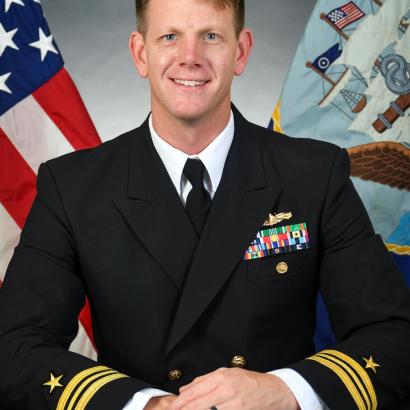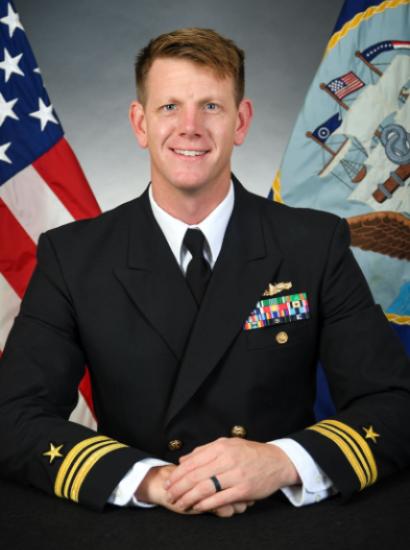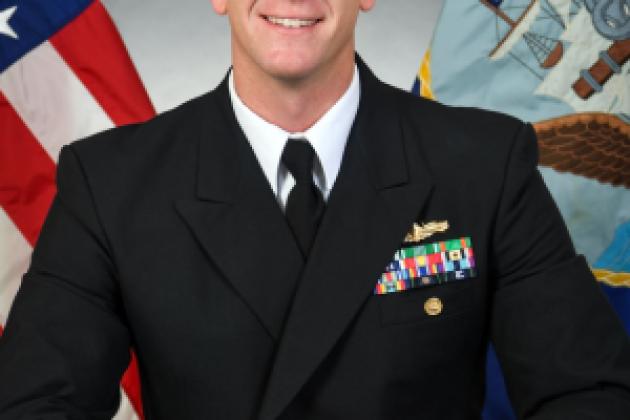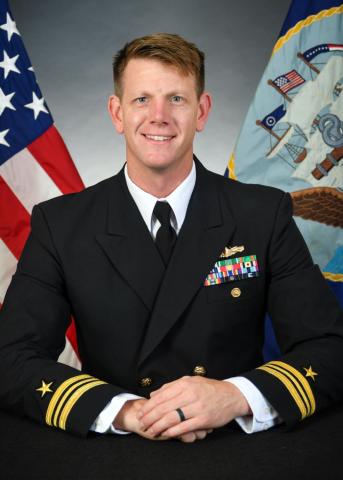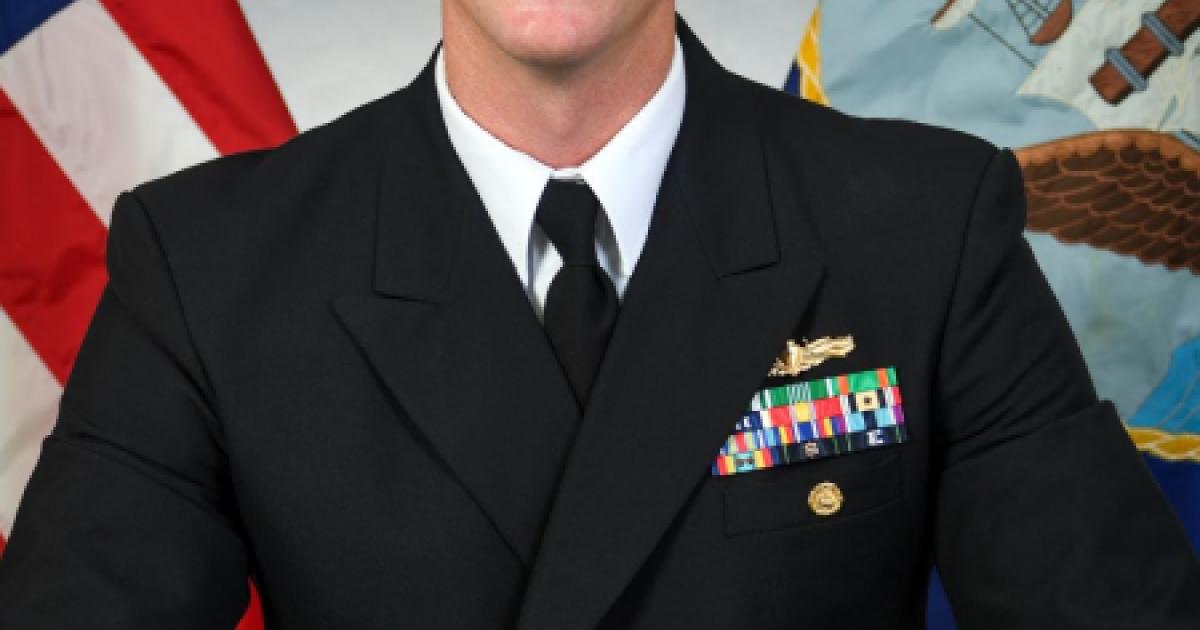By Jonathan Movroydis
Lieutenant Commander Brian Michael Harrington is a National Security Affairs Fellow for the academic year 2021–22.
In this Q&A, Harrington discusses his two-decade-long career in the US Navy, including deployments to the Middle East, Europe, Africa, and Asia.
Harrington most recently served as the operations and plans officer at Task Force Six-Four, the Sixth Fleet Integrated Air and Missile Defense cell in Naples, Italy. In this role, he worked with European counterparts on ballistic missile defense.
Harrington describes Russia’s naval activity in the seas surrounding the Eurasian landmass and references a recent article he wrote for The Hill about how the United States and NATO partners can work together to counter and contain aggression from Moscow. Harrington explains that he will spend his fellowship at Hoover, in part, researching ways in which the United States and partner Asian nations can apply the best practices of the longstanding NATO alliance to deter Chinese aggression and maintain stability and security in the Indo-Pacific region.
Why did you join the US Navy?
I joined the US Navy because it was an opportunity to serve my country, to be a part of something larger than myself, and to satisfy a sense of adventure. There is also a history of service in my family. My father was an officer in the Navy, his father was in the Navy, and my other grandfather was in the Army in World War II.
Will you talk about your educational background?
I studied US history at the University of Virginia, where I was also on the swim team. Following graduation, I went to officer candidate school and subsequently received my commission in the US Navy. A few years later, I had the opportunity to attend the Naval Postgraduate School down the road from here in Monterey and completed a master’s program in national security affairs. While I studied there, I came up to Stanford to conduct research in the Hoover Archives.
What was the nature of your research at the Hoover Library & Archives?
I was studying propaganda in the early nuclear age and researching for my master’s thesis. It was a fun topic, and there are some interesting posters and documents here at Hoover.
My thesis looked at how the US government tried to gin up public support for early nuclear policy during the Cold War—specifically the concept of mutually assured destruction (MAD). I watched a lot of old films and TV shows that presented an optimistic view of the nuclear age. In retrospect, some of this content seems comical. Such content includes instructing children to seek shelter under their desks in the event of a nuclear explosion, as if that would have mattered.
At this point in the 1950s, the train had already left the station. The Soviets were building up their nuclear program and the United States was trying to maintain parity with its superpower rivals.
Did you find that the propaganda was effective?
Yes, in that there was public support overall for the nuclear program and its funding. However, what I didn’t find true was the widespread belief back then that the nuclear bomb would revolutionize the future of conflict. I think that very early on a lot of top theorists believed that war would never be the same. But in analyzing the nature of the Korean War, Vietnam War, the first Gulf War, and our most recent wars in Iraq and Afghanistan, things were much more similar than they were different in conflict before the bomb.
This has some modern-day application today as well. Many people want to jump to the conclusion that the advent of new technologies will forever change the way that wars are fought and resolved. But it seems to me that, in many respects, the more things change, the more they stay the same.
Will you describe your work as a surface warfare officer?
Surface warfare officers train to maneuver ships to project US power worldwide, support joint operations from the sea, and deter and defeat our nation’s maritime adversaries. They spend a lot of time at sea. They start out at a division level with approximately ten to twenty subordinate sailors. They are also in charge of several pieces of equipment on ships. Above that, at the department head level, a surface warfare officer is responsible for a couple of divisions and a larger number of people and equipment. At the top of this chain is the commanding officer or captain of the ship.
Ultimately, surface warfare officers are problem solvers. They don’t necessarily have the technical expertise of a pilot or nuclear engineer on a submarine. Rather, our job is to organize the technical experts around a common purpose.
Where have you been deployed?
Most of my deployments have been on destroyers out of San Diego, California, and Norfolk, Virginia. From there, I have embarked across a spectrum of operations from escorting carriers in the Indian and Pacific oceans and deploying on counter piracy missions in the Red Sea and Horn of Africa to managing our ballistic missile defense posture from our base in Naples, Italy, in defense of our allies and interests in the Mediterranean and throughout the Middle East and Central Asia.
I also was assigned to an off-the-beaten-path deployment in which I drove riverboats in the Tigris and Euphrates rivers. We were charged with interdicting Iranians who were smuggling weaponry into Iraq.
What type of naval operations does the United States conduct in Naples, Italy?
The second largest overseas presence of the US Navy is in Naples. It's important because it's the home of the Navy’s Sixth Fleet, which is run by a three-star admiral who also leads NATO’s Striking and Support Forces, its principal naval services command. The commander of US Naval Forces Europe and Africa—a four-star admiral—is also based in Naples.
Our presence in Naples is more of a command-and-control center than it is a strategic base. Most of our ships are stationed in Rota, in the south of Spain.
Commanded by our headquarters in Naples, our ships patrol the Mediterranean, the Black Sea, the North Atlantic, and the Baltics. Our Navy mainly conducts Iranian-facing ballistic missile defense and anti-submarine operations and patrols to deter potential Russian aggression.
In Eurasia, how does Russia’s naval presence compare with the United States’?
The United States can’t be everywhere at once, so in some places the Russians have placed themselves in a position to exercise coercion over our allies. After Russian forces annexed the Crimea in 2014, they placed on its shores land-based coastal defense cruise missiles and have expanded their presence in the Black Sea. I wrote an article in The Hill in October in which I suggested ways the United States and NATO allies could counter Russian dominance in that strategically important body of water bordering the former Soviet Bloc and Turkey.
The Russians have a large presence in the eastern Mediterranean as well, providing material support and military backing of the Assad dictatorship in Syria. Their submarine activity in the North Atlantic is reminiscent of the cat-and-mouse pursuits during the Cold War.
Russia doesn’t have a global naval presence like the United States and not nearly as much wealth. However, they have some very high-end capabilities that enable them to be a formidable strategic rival in the areas I just mentioned.
What will be your research focus at Hoover?
My research focus will be twofold. During my deployment to Naples, I worked a lot with European counterparts in NATO, which is a longstanding, high-functioning, and very interoperable alliance. I am interested in finding out ways that we can apply NATOs principles to partner nations in the Indo-Pacific against threats posed by the People’s Republic of China. I am not advocating an Asian version of NATO, but I believe it offers some very good examples of how we can strengthen current security partnerships to counter Beijing.
Another topic I am interested in is exploring ways in which we can strengthen the culture of the US Navy. During the last two decades, the Navy has played an important but subordinate role in land-based counter-terrorism operations in the Middle East. We now find ourselves again in an era of great power competition where our technological advantage and all-domain dominance merits reassessment. There are a mindset shift and organizational cultural changes that might better prepare us for competition or potential conflict in the Indo-Pacific that would be centered largely on the maritime domain.
Regarding the first topic of study that you discussed, do you think that the United States and its partners could mount a strong defense without something like an Article 5 commitment to collective defense that is a central component to the NATO alliance?
There are some countries in the Indo-Pacific that are much more reliable right now than others. For example, we have strong military-to-military ties with Japan and South Korea, which were forged following our victory in the Second World War. We have a long-standing alliance with Australia, which has been recently reinforced through the $30 billion nuclear submarine deal.
I also think that the Quad group of countries (United States, Australia, India, and Japan) has the potential to be an effective counterweight to China—not only based on military cooperation but also in other areas including the sharing of advanced technologies and working together to build reliable supply chains.
In the Indo-Pacific, a US fleet cannot counter a five-hundred-ship Chinese navy alone. We need to share that responsibility with capable partners in the region.
I don’t think we are anywhere close to achieving an Article 5 type of ultimatum. Right now, the biggest question is which countries would get involved if China decided to attack Taiwan.
Has there been anyone at Hoover who made you think differently about the topics that you are studying?
Secretary Condoleezza Rice has really made me think much more holistically—especially about how domestic and foreign policy issues are often intertwined.
Amy Zegart, who coordinates the National Security Affairs fellowship, has raised my awareness about how America’s defense apparatus is lagging significantly behind the private sector in technological expertise and innovation. She has inspired my thinking on how new and emerging technologies might be leveraged to solve many of our national security challenges.
Where do you look for inspiration?
One of the places I always look for inspiration is very close to home with my family. Their actions remind me that service doesn't always look the same. There are a lot of ways to get there. My mother is a teacher. I have a sister who's a neonatologist and saves newborn babies every day. I have another sister who as a college lacrosse coach helps shape young women’s minds and inspires them to become future leaders. So, looking at my family offers insight on many ways people can contribute to the greater good of their society. That is inspirational.
Here at Hoover, I have had the opportunity to talk with General Jim Mattis and Admiral James O. Ellis on a few occasions. Those two men have dedicated their entire lives’ work in service to the nation.
Finally, as a military officer over the past two decades, I have been inspired by the people to my left and right who also volunteered and set aside their personal differences to work toward the common goal of defending our way of life.
What does leadership mean to you?
Put simply, leadership to me means inspiring people to work together and solve a common problem. I think great leadership begins with trust and flourishes from there.








